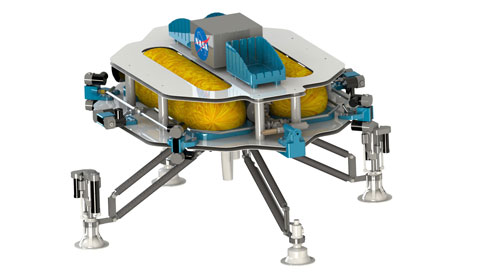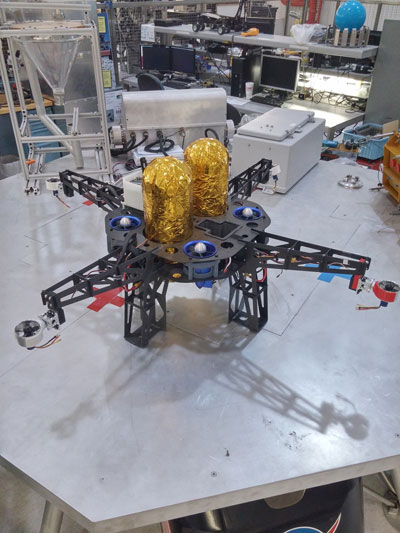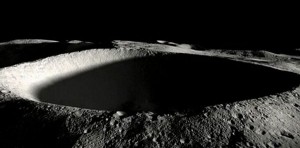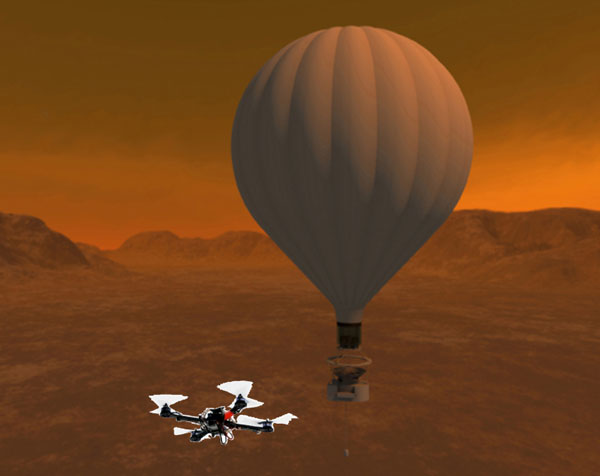
NASA/Swamp Works
Flying robot explorers could one day grace the skies of other worlds. Quadcopters, the four-propeller drones that have become a familiar sight in terrestrial skies, may be the next big thing in space exploration. Engineers based at NASA’s Kennedy Space Center on the Florida Space Coast are working on the next generation of robotic scouts to take planetary exploration airborne.
The facility, known as Swamp Works, is designing small flying probes which will be capable of reaching hard-to-access spots, such as crater walls or crevasses.
Engineers are designing these prototypes for use in harsh environments. Navigation based on the Global Positioning System (GPS) would be unavailable for an EAF based on Mars or an asteroid. Moreover, the flyers would have to be completely autonomous, able to make snap decisions on their own as they operate on surfaces of worlds several light-minutes away from Mission Control here on Earth.
Drones to Explore the Solar System

NASA / Swamp Works
NASA is looking to develop these flying scouts as the next logical evolution in planetary exploration, following the success of its rover program. Lunar and Mars rovers trace a lineage all the way back to the Soviet Union’s first Lunokhod 1 Moon rover in 1970 and the Prop-M rovers aboard the ill-fated Mars 2 and Mars 3 missions. NASA has fielded four successful rovers on Mars, starting with Sojourner in 1997 and continuing with Spirit, Opportunity, and Curiosity, as well as a new Curiosity look-alike rover with all-new instruments set to head to the Red Planet in 2020.
Though Swamp Works is conducting initial tests using ducted fan motors, the flyers will ultimately maneuver in the mostly airless environments of the Moon, Mars, or an asteroid using cold-gas jets. The flyers would utilize steam or nitrogen gas to maneuver as they venture out for small samples, returning to a larger base vessel for periodic recharging.
“One of the reasons we chose the propellant systems that we did is so they could replenish themselves via a method known as In Situ Resource Utilization (ISRU),” says Mike DuPuis, co-investigator for the Extreme Access Flyer (EAF) project. Future missions could ultimately scale up this technology to mine for vital resources — such as water — ahead of the arrival of astronauts. “Every kilogram mined on-site is a kilogram that astronauts wouldn’t have to bring with them,” DuPuis said.
Swamp Works is an ideal laboratory for extreme flyers, as it houses capabilities used to simulate otherworldly environments, such as the Granular Mechanics and Regolith Operations Laboratory, the Electrostatics and Surface Physics Laboratory, and the Regolith Activities Testbed. These facilities simulate the kind of conditions an EAF might encounter on the surface of an asteroid or Mars. Engineers are also working on giving the flyers the ability to recognize the terrain in order to plot a course using laser guidance and autonomous onboard navigational systems.

NASA
“An example is Shackleton crater on the south pole of the Moon, which is in permanent shadow,” DuPuis said. “Such a region is cold enough to freeze a rover, whereas an EAF could do repeated quick ‘dash and grab’ missions.”
The advent of 3D printing has also streamlined the development of a successful prototype flyer. Often, off-the-shelf components for one-of-a-kind prototypes simply didn’t exist, and in the past, off-site fabrication was a time-consuming process. Now engineers can often custom-order and 3D-print any needed parts on-site.
Flyers Now and in the Near-Future
Swamp Works engineers began the project about two years ago and are currently testing one large quadcopter as well as several smaller prototypes, working out the drones’ control capabilities. Honeybee Robotic Spacecraft Mechanisms and Embry-Riddle Aeronautical University also help with guidance and control systems.
Extreme Access Flyer technology may have Earthly applications as well. Researchers could send a remote flyer into zones dangerous for humans, such as a caldera of an active volcano. Emergency first responders could also deploy a flyer to survey the site of a toxic spill or nuclear catastrophe.
Robotic flyers could also pave the way for human habitation on other worlds. Lava tubes on the Moon and Mars provide natural shielding from micrometeorites and dangerous radiation, and such sites would be ideal for a future outpost on the Moon or Mars. An extreme access flyer may give us our first glimpses inside these lava tubes, and open them up for further exploration.
Certainly, the pipeline from mission development and proposal to approval is a long one, but designers might incorporate Extreme Access Flyers aboard future missions in the decades to come.

NASA / JPL
One such proposal calls for a balloon-based quadcopter to explore the atmosphere and surface of Saturn’s largest moon, Titan. Unlike Mars, Titan has a dense enough atmosphere to allow rotor propulsion. The quadcopter would make trips to the frigid surface of Titan, returning periodically to the balloon to recharge, using its nuclear-powered Radioisotope Thermoelectric Generator.
Extreme Access Flyers promise to open up new planetary vistas and usher in a new generation of planetary exploration.
 3
3
Comments
August 21, 2015 at 1:06 pm
Insight is not the name of the 2020 rover. Insight is a stationary lander that will be launched - and land on Mars - in 2016.
As far as I know, the 2020 rover has not yet received a formal name.
- John Sheff
Cambridge, MA
You must be logged in to post a comment.
Monica Young
August 24, 2015 at 9:57 am
Thank for the catch, John, I've corrected the post.
You must be logged in to post a comment.
August 24, 2015 at 7:56 am
We don’t need meteorite. We are already wreaking havoc around this beautiful blue sphere that we call home. From the far side of Pluto to next generation rover for Mars, Are We Heading to The Next Dimension of Space Explorations?
You must be logged in to post a comment.
You must be logged in to post a comment.